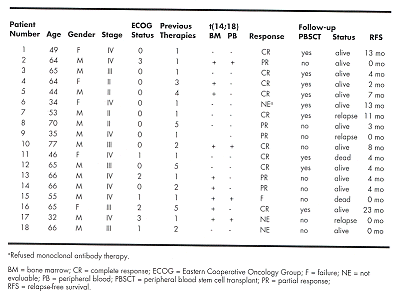Relapsed Follicular Lymphoma: Response to a Fludarabine/Mitoxantrone Regimen and the Monoclonal Anti-CD20 Antibody Rituximab
Our objective was to determine the efficacy of a fludarabine (Fludara)/mitoxantrone (Novantrone) regimen combined with the monoclonal anti-CD20 antibody rituximab (Rituxan) to induce clinical and molecular remissions in patients with relapsed
Our objective was to determine the efficacy of a fludarabine (Fludara)/mitoxantrone (Novantrone) regimen combined with the monoclonal anti-CD20 antibody rituximab (Rituxan) to induce clinical and molecular remissions in patients with relapsed follicular lymphoma.
A prospective trial was conducted in 18 consecutive relapsed patients with follicular lymphoma. Fludarabine at 30 mg/m2 days 1 to 3 and mitoxantrone at 10 mg/m2 day 1 were administered monthly for 4 months followed by rituximab at 375 mg/m2 weekly × 4. Eligible patients had relapsed nodal follicular non-Hodgkin’s lymphoma with bcl-2 and CD20-positive expression, Eastern Cooperative Oncology Group (ECOG) performance status < 3, normal liver and renal function, and no concomitant diseases. Both clinical and molecular responses were evaluated; polymerase chain reaction (PCR) assays for t(14;18) in peripheral blood and bone marrow prior to therapy, after fludarabine/mitoxantrone chemotherapy, and after rituximab treatment were completed.
Patients included (see table for details) 13 males and 5 females, with a mean age of 52.3 ± 13.4 years (range: 32 to 77 years), and ECOG status of 0 (11 patients), 1 (3), 2 (2), or 3 (2). Clinical stage was determined to be II (4 patients), III (5), or IV (9), with 1 (10 patients), 2 (3), or ³ 3 (5) previous therapies. Before therapy, bone marrow showed positive PCR t(14;18) in 10 cases (55.5%), and 4 (22.22%) were positive in peripheral blood.

A total of 16 patients were evaluable for response; after fludarabine/mitoxantrone therapy, 5 patients showed complete responses (CR) (31.25%), 10 partial responses (PR) (62.50%), and 1 failure (6.25%). After rituximab therapy (15 patients) the response rates were 9 CR (60.0%), 5 PR (33.33%), and 1 failure (6.66%). According to 10 cases with positive PCR t(14;18) in bone marrow, 8 (80.0%) achieved molecular remission (1 was after fludarabine/mitoxantrone therapy-the patient was excluded for rituximab therapy), 1 patient is continuously PCR t(14;18)-positive, and the remaining patient is under therapy.
CONCLUSION: Fludarabine/mitoxantrone therapy induces clinical response in 93.75% of patients with relapsed follicular lymphoma, with a CR rate of 31.25%. Rituximab therapy does not influence overall response but improves CR rate (60.0%). Furthermore, it is capable of obtaining in vivo purging in 77.77% of cases. For these reasons, combined fludarabine/mitoxantrone chemotherapy plus rituximab could be a good therapeutic scheme to produce in vivo purging before stem cell harvesting in patients undergoing autologous stem cell transplantation.
Click here to read Dr. Bruce Cheson's commentary on this abstract.
Highlighting Insights From the Marginal Zone Lymphoma Workshop
Clinicians outline the significance of the MZL Workshop, where a gathering of international experts in the field discussed updates in the disease state.